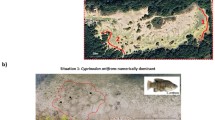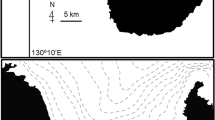Abstract
Coexistence mechanisms of permanently territorial fishes proposed hitherto have been mainly based on interspecific competition. To test the hypothesis of the coexistence through male-mating aggression (Kohda, 1995a), spacing patterns of feeding territories of three coexisting herbivorous cichlids, Petrochromis polyodon, P. trewavasae and P. famula, were investigated in a homogeneous habitat at a shallow rocky shore in Lake Tanganyika. All three species maintained individual feeding territories that were defended against both con-specifics and congenerics and rarely overlapped either intra-or interspecifically. Territories of three species were scattered and covered almost all rocky bottoms. Territorial attacks usually occurred near the border of feeding territories. But male P. polyodon, the largest and socially most dominant fish, attacked conspecific males far beyond their feeding territories, which were widely separated. Removal of some territory owners suggested that such attacks result in the separate distribution of male P. polyodon territories. The interstitial space between P. polyodon feeding territories resulting from their mating aggression can be occupied by subordinate congeneric fishes. Male-mating attack of dominant males of Petrochromis will facilitate the coexistence of other congeners.
Access this chapter
Tax calculation will be finalised at checkout
Purchases are for personal use only
Preview
Unable to display preview. Download preview PDF.
Similar content being viewed by others
References cited
Brichard, P. 1989. Cichlids and all the other fishes of Lake Tanganyika. T.F.H. Publications, Neptune City. 544 pp.
Chesson, P.L. & R.P. Warner. 1981. Environmental variability promotes coexistence in lottery competitive systems. Amer. Nat. 117: 923–943.
Coulter, G.W. 1991. Lake Tanganyika and its life. Oxford University Press, London. 354 pp.
Ebersole, J.P. 1985. Niche separation of two damselfish species by aggression and differential microhabitat utilization. Ecology 66: 14–20.
Hert, E. 1995. The impact of intralacustrine introductions with regard to space utilization and competition for territories to a cichlid fish community in Lake Malawa, Africa. Ecol. Res. 10: 117–124.
Hori, M. 1987. Mutualism and commensalism in a fish community in Lake Tanganyika. pp. 219–239. In: S. Kawano, J.H. Connell & T. Hidaka (ed.) Evolution and Coadaptation in Biotic Communities, University of Tokyo Press, Tokyo.
Hori, M. 1991. Feeding relationships among cichlid fishes in Lake Tanganyika: effects of intra- and interspecific variations of feeding behavior on their coexistence. INTECOL Bull. 19: 89–101.
Itzkowitz, M. 1977. Spatial organization of the Jamaican damsel-fish community. J. Exp. Mar. Biol. Ecol. 28: 217–242.
Itzkowitz, M. 1978. Group organization of a territorial damsel-fish, Eupomacentrus planifrons. Behaviour 65: 125–137.
Kawanabe, H. 1981. Territorial behaviour of Tropheus moorei ( Osteichthyes: Cichlidae) with a preliminary consideration on the territorial forms in animals. Afr. Stud. Monogr. 1: 101–108.
Kohda, M. 1984. Intra-and interspecific territoriality of a temperate damselfish, Eupomacentrus altus (Teleostei: Pomacentridae). Physiol. Ecol. Japan 21: 35–52.
Kohda, M. 1991. Intra-and interspecific social organization among three herbivorous cichlid fishes in Lake Tanganyika. Japan. J. Ichthyol. 38: 147–163.
Kohda, M. 1995a. Does male-mating attack in the herbivorous cichlid, Petrochromis polyodon, facilitate the coexistence of congeners? Ecol. Fresh. Fish. 4: 152–159.
Kohda, M. 1995b. Territoriality of male cichlid fishes in Lake Tanganyika. Ecol. Fresh. Fish. 4: 180–184.
Kohda, M. & Y. Yanagisawa. 1992. Vertical distributions of two herbivorous cichlid fishes of the genus Tropheus in Lake Tanganyika. Ecol. Fresh. Fish. 1: 99–103.
Kuwamura, T. 1986. Parental care and mating systems of cichlid fishes in Lake Tanganyika: a preliminary field survey. J. Ethol. 4: 129–146.
Kuwamura, T. 1987. Male mating territory and sneaking in a maternal mouthbrooder, Pseudosimochromis curvifrons ( Pisces: Cichlidae). J. Ethol. 5: 203–206.
Kuwamura, T. 1992. Overlapping territories of Pseudosimochromis curvifrons males and other herbivorous cichlid fishes in Lake Tanganyika. Ecol. Res. 7: 43–53.
McKaye, K.R. 1984. Behavioural aspects of cichlid reproductive strategies: patterns of territoriality and brood defence in Central American substratum spawners and African mouth brooders. pp. 245–273. In: R.J. Wooton & G.W. Potts (ed.) Fish Reproduction: Strategies and Tactics, Academic Press, London.
Myrberg, A.A. & R.E. Thresher. 1974. Interspecific aggression and its relevance to the concept of territoriality in reef fishes. Amer. Zool. 14: 81–96.
Ochi, H. 1993. Maintenance of separate territories for mating and feeding by males of a maternal mouthbrooding cichlid, Gonathochromis pfefferi, in Lake Tanganyika. Japan. J. Ichthyol. 40: 173–182.
Pianka, E.R. 1978. Evolutionary ecology. Harper and Row, New York. 397 pp.
Poll, M. 1986. Classification des Cichlidae du lac Tanganyika: tribus, generes et especes. Mem. Acad. Roy. Belgium (Sei.) 45: 1–163.
Robertson, D.R. 1984. Cohabitation of competiting territorial damselfishes on a Caribbean coral reef. Ecology 65: 1121–1135.
Robertson, D.R. & S.D. Gaines. 1986. Interference competition structures habitat use in a local assemblage of coral reef surgeonfishes. Ecology 67: 1372–1383.
Robertson, D.R. & B. Lassing. 1980. Spatial distribution patterns and coexistence of a group of territorial damselfishes from the Great Barrier reef. Bull. Mar. Sci. 30: 187–203.
Robertson, D.R., Y. Nicholas, C. Polunin & K. Leighton. 1979. The behavioral ecology of three Indian Ocean surgeonfishes (Acanthurus lineatus, A. leucosternon and Zebrasoma scopsa): their feeding strategies, and social and mating systems. Env. Biol. Fish. 4: 125–170.
Rossiter, A. 1994. Territory, mating success, and the individual male in a lekking cichlid fish. pp. 43–55. In: P.J. Jarman & A. Rossiter (ed.) Animal Societies, Kyoto University Press, Kyoto.
Sale, P.F. 1974. Mechanism of co-existing in a guild of territorial fishes at Heron Island. Proc. Inter. Coral Reef Symp. 1: 193–206.
Sale, P.F. 1977. Maintenance of high diversity in coral reef fish communities. Amer. Nat. 111: 337–359.
Sale, PF. 1978. Coexistence of coral reef fishes - a lottery for living space. Env. Biol. Fish. 3: 85–102.
Sale, P.F. 1982. Stock-recruit relationships and regional coexistence in a lottery competitive system: a simulation study. Amer. Nat. 120: 139–159.
Sale, P.F. 1991. Reef fish communities: open nonequilibrial systems. pp. 564–598. In: P.F. Sale (ed.) The Ecology of Fishes on Coral Reefs, Academic Press, San Diego.
Takamura, K. 1984. Interspecific relationships of Aufwuchs-eat- ing fishes in Lake Tanganyika. Env. Biol. Fish. 10: 225–241.
Thresher, R.E. 1976. Field analysis of the territoriality of the threespot damselfish, Eupomacentrus planifrons ( Pomacentridae ). Copeia 1976: 266–276.
Tilman, D. 1982. Resource competition and community structure. Princeton University Press, Princeton. 296 pp.
Yamaoka, K. 1982. Morphology and feeding behaviour of five species of genus Petrochromis (Teleostei: Cichlidae). Physiol. Ecol. Japan 19: 57–75.
Yamaoka, K. 1983. A revision of the cichlid fish genus Petrochromis from Lake Tanganyika, with description of a new species. Japan. J. Ichthyol. 30: 129–141.
Yamaoka, K. 1991. Feeding relationships. pp. 151–172. In: M.H.A. Keenleyside (ed.) Cichlid Fishes, Chapman & Hall, London.
Yanagisawa. Y. & M. Nishida. 1991. The social and mating system of the maternal mouthbrooder Tropheus moorii (Cichlidae) in Lake Tanganyika. Japan. J. Ichthyol. 38: 271–282.
Author information
Authors and Affiliations
Editor information
Rights and permissions
Copyright information
© 1998 Springer Science+Business Media Dordrecht
About this chapter
Cite this chapter
Kohda, M. (1998). Coexistence of permanently territorial cichlids of the genus Petrochromis through male-mating attack. In: Yuma, M., Nakamura, I., Fausch, K.D. (eds) Fish biology in Japan: an anthology in honour of Hiroya Kawanabe. Developments in environmental biology of fishes, vol 18. Springer, Dordrecht. https://doi.org/10.1007/978-94-015-9016-7_17
Download citation
DOI: https://doi.org/10.1007/978-94-015-9016-7_17
Publisher Name: Springer, Dordrecht
Print ISBN: 978-90-481-5048-9
Online ISBN: 978-94-015-9016-7
eBook Packages: Springer Book Archive




